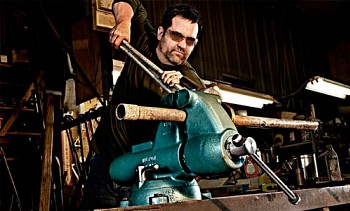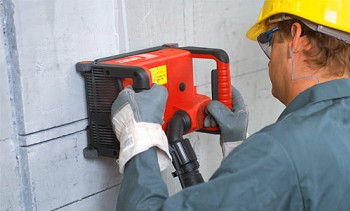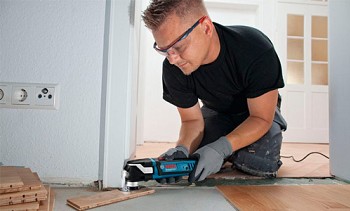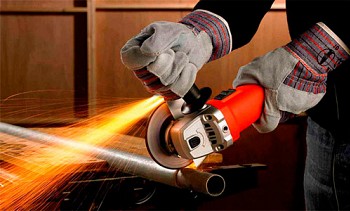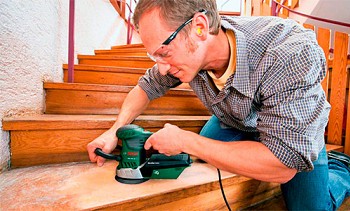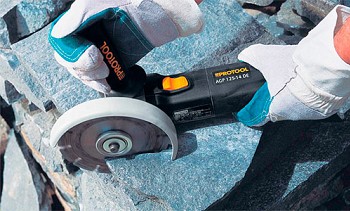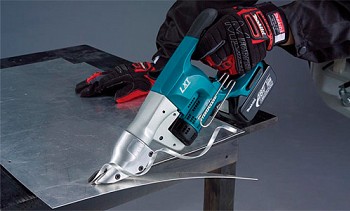Angle grinder is a convenient and versatile tool used in large industries and in home workshops. The proposed article will allow the reader to get an idea about the features of the angle grinder, the principle of operation and technical characteristics. Processing almost any material at home is not difficult when using a modern power tool. Angle grinders (angle grinders) of various models are freely sold in specialized stores and are available to a wide range of users. How to choose a grinder that would best meet the specific requirements of the client? To answer this question, let's try to figure out together what kind of tool it is and what its parameters are.
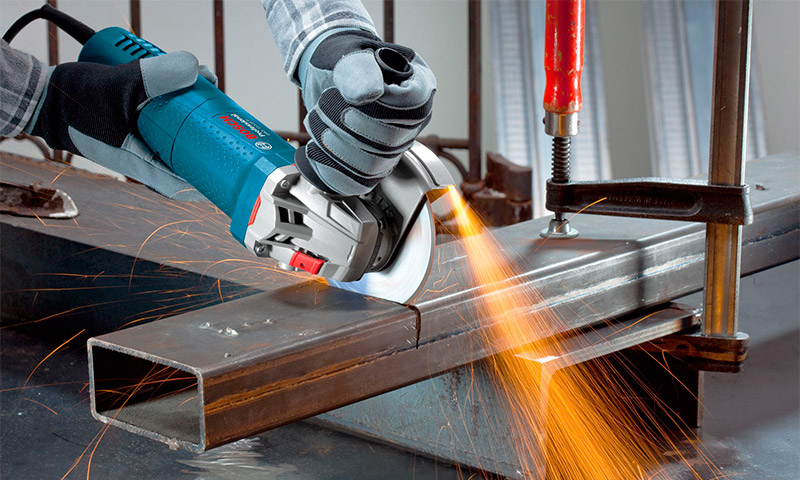
Content:
- Purpose and scope of angle grinder
- The device of angle grinders, components
- Power, revolutions and tooling diameter
- For home or professional model
- Additional systems for providing work with the tool
- Handles of their variety and adjustment
- Cordless angle grinders - features of their choice
- Types of equipment for the "grinder": the rules for its use and selection
- Safety regulations
- Video: Choosing a "grinder"
Purpose and scope of angle grinder
The term "Bulgarian" to refer to this building tool appeared in the Soviet Union in the early 70s of the last century. This name was given to angle grinders due to their place of origin; their manufacture was established at the Altos-Bulgarian plant in Plovdiv. The angle grinder was designed by Ackermann + Schmitt (FLEX-Elektrowerkzeuge GmbH) in Steinheim an der Moore in 1954. Angle grinder quickly gained popularity among specialists, its versatility became one of the main factors for the success of the tool.
Using special equipment allows using angle grinders to perform operations on cutting and grinding a wide range of different materials:
It is not recommended to use a grinder for cutting glass and wood, due to the high linear speed at the touch point of the tool, heating and ignition are possible. In recent years, circular saws have been manufactured for working with lumber from special refractory alloys. This equipment should be used very carefully and should not be allowed to overheat. The above list of materials defines the main areas of application of angle grinders.
This power tool is widely used:
- In construction.
- At enterprises related to metalworking.
- In car service workshops for bodywork.
A lot of angle grinders are in the hands of the population, homeowners are actively using them to perform housework. With its help, cutting and grinding of the above materials is carried out. This power tool, in particular, processes welds and removes scale. The operation does not take much time and allows you to do without unnecessary shock loads on a fresh joint.
The device of angle grinders, components
The construction of angle grinders is distinguished by a relatively simple and technologically advanced design, which made it possible to establish their production at many enterprises.
Angle grinder consists of the following parts:

 The case, which is made of reinforced polymers.Such materials are characterized by high strength, resistance to wear and environmental influences. On the outer surface is a power button with a lock. Some models have windows closed with hatches to replace the drive brushes.
The case, which is made of reinforced polymers.Such materials are characterized by high strength, resistance to wear and environmental influences. On the outer surface is a power button with a lock. Some models have windows closed with hatches to replace the drive brushes.
 An electric motor powered by a household network or batteries. At angle grinders, drives are used that can provide high shaft speeds. To cool the windings and other parts, a fan is installed in the front part on the axis.
An electric motor powered by a household network or batteries. At angle grinders, drives are used that can provide high shaft speeds. To cool the windings and other parts, a fan is installed in the front part on the axis.
 Single-stage angular gear in a separate housing made primarily of magnesium or aluminum alloys. Consists of bevel gears, whose shafts are mounted on ball or plain bearings. The interaction between the parts in the gearbox is provided by a housing that is filled with grease.
Single-stage angular gear in a separate housing made primarily of magnesium or aluminum alloys. Consists of bevel gears, whose shafts are mounted on ball or plain bearings. The interaction between the parts in the gearbox is provided by a housing that is filled with grease.
 Spindle, consisting of a shaft with a metric thread, a thick-walled washer and a nut for attaching a cutting disc or other equipment. On the gearbox housing, a button is usually provided on the opposite side to lock the shaft in motion. This is necessary for dismantling and installing new equipment.
Spindle, consisting of a shaft with a metric thread, a thick-walled washer and a nut for attaching a cutting disc or other equipment. On the gearbox housing, a button is usually provided on the opposite side to lock the shaft in motion. This is necessary for dismantling and installing new equipment.
 The removable handle is threaded and can be screwed into the gear housing in one of the selected positions. This is done for the convenience of holding the power tool in the process of performing various types of work.
The removable handle is threaded and can be screwed into the gear housing in one of the selected positions. This is done for the convenience of holding the power tool in the process of performing various types of work.
 Protective cover, covers part of the cutting disc and does not allow a sheaf of sparks, which are formed during operation to fly in all directions. The device protects the worker and surrounding objects from wear products of equipment and fragments of material formed during its processing.
Protective cover, covers part of the cutting disc and does not allow a sheaf of sparks, which are formed during operation to fly in all directions. The device protects the worker and surrounding objects from wear products of equipment and fragments of material formed during its processing.
An angle grinder is supplied to the consumer complete with a user manual and a special key for attaching the equipment. The latter is a steel strip with two pins that exactly match the holes of the fixing nut. In some cases, the manufacturer adds spare carbon brushes to the package.

The principle of operation of angle grinders
The angle grinder is driven by an electric motor, which is activated by pressing a latching button or switch. Power is supplied from the network, as well as from a built-in or removable battery. Mostly the tool is equipped with collector motors, the stator winding of which has a large inductive resistance. This circumstance can significantly reduce operating currents.
By unwinding, the motor shaft rotates the drive gear in the gearbox, which drives the driven gear, and thus transfers force to the spindle. The mechanism case is made of magnesium or aluminum alloys to improve heat transfer. The gearing between gears is of two types: spur and helical (conical Glisson system). The second option is preferable because it provides greater reliability and helps to reduce noise.
On more expensive and complex models, a trip clutch is used that is installed between the motor and gearbox. The main function of this unit is to prevent a reverse impact when the disk suddenly stops due to jamming. This protects the operator from possible injury and the components of the grinder from damage. On such angle grinders, the spindle lock button can be pressed until it stops completely.
The choice of a design scheme in which the plane of rotation of the cutting disc or brush is parallel to the axis of the tool is explained quite simply. When working with angle grinders, a significant torque arises, tending to divert the tool to the side. This effort is easily compensated by the operator, due to the optimal position of the arms along and perpendicular to the axis.

Power, revolutions and tooling diameter
Given the significant difference in parameters between different models of angle grinders, the question arises, which is better to buy a grinder for home or work? It should be decided: to perform, what operations it is necessary, and what are the volumes of the proposed work.
Rotational speed
One of the main parameters of angle grinder is the linear speed of rotation of the circle, which depends on the diameter of the circle. The optimal value for this indicator is 80 m / s, a significant deviation of the rotational speed upwards will lead to the destruction of the circle. A lower speed causes rapid wear on the disc. There are five types of angle grinders that vary in the size of the cutting wheels used.
The dependence of the spindle speed on the diameter of the working disk is as follows:

115 mm - 13290 rpm

125 mm - 12230 rpm

150 mm - 10190 rpm

180 mm - 8490 rpm

230 mm - 6650 rpm
The data on the permissible rotational speeds of the cutting wheel for each particular model must be indicated on a special plate that is attached to the body. The magnitude of the torque in this case should be sufficient to overcome the arising frictional force and maintain the necessary cutting speed. This characteristic is determined by the rated power of the electric motor of the grinder.
Power angle grinder
The rated power of grinders ranges from 650 to 2700 watts, and depends on the diameter of the disk used. Accordingly, angle grinders designed for large-diameter discs have more powerful drives. With these parameters, the electric motor provides a force on the cutting edge of the wheel sufficient to effectively affect the material being processed.
For normal operation, it is necessary that the power consumption of angle grinders with a disk diameter of 125 mm be at least 750 watts. Moreover, the larger the diameter of the permissible equipment, the more powerful the engine should be. So in models with a tooling diameter of 230 mm, which are designed for intensive use at construction sites, the power consumption of the engine should be at least 2200 watts.
Tool diameter
Be sure to decide which tooling diameter will be sufficient for your needs. Remember that you cannot use circles whose diameter is larger than the permissible limit. Of course, you can do this by removing the protective cover, but such manipulations are prohibited, as they can lead to injury to the operator. It is especially dangerous to use angle grinders without a protective casing when working with metal disks with hard-fused soldering, which, when flying, can cause significant harm to health up to death. If you have such a desire, just search the Internet for photos of people who received injuries while neglecting safety when working with angle grinders and this desire will disappear forever.
The diameter of the tool is deeply related to such a parameter as the depth of cut. This point is especially important if you are going to cut curbs and other materials with a large thickness using angle grinder. The cutting depth of the model with a disk diameter of 125 mm is only 30 mm - 35 mm, depending on the model. All because immersing the circle in the material completely will not allow the dimensions of the gearbox.
Of course, you can cut the curb stone by making cuts from two sides. But to make such a cut qualitative is more difficult, and it will take more time. Therefore, if you have to constantly cut such materials, then you should look in the direction of the "grinders" with a maximum disk diameter of 230 mm.

Angle grinders with a small working circle are unsuitable for cutting superhard materials, and large models are inconvenient for grinding a car body.
For home or professional model
To determine which grinder to choose for the house, and which for intensive work, you need to proceed from its technical indicators.The entire power tool, including angle grinders, is divided into household and professional, depending on the time of continuous operation. Household angle grinders are designed for occasional use 30 - 40 minutes a day. Professional models are designed for the exhaustive use of the tool throughout the day or work shift. Professional angle grinders have enhanced protection against dust, noise and a number of systems that are designed to provide comfort and safety for the operator.
If the angle grinder is designed to perform small homework, then it is worth paying attention to models with disc diameters of 115 mm, 125 mm or 150 mm. The most common model for the home is a angle grinder with a disc diameter of 125 mm. To understand how to choose the angle grinder for the home, it is necessary to outline the range of tasks and a list of processed materials. Obviously, the acquisition of an expensive professional tool in this case is unjustified.
As for professional models, here the absolute leader is angle grinder with disc diameter 230 mm. When choosing such a model, you should pay attention to the diameter of the engine. The larger the diameter of the engine, the greater torque can be developed by angle grinders, and this is very important during exhausting operation. Therefore, if you choose between two approximately equal angle grinders, give preference to one that has a larger motor diameter and only secondarily look at power. Some manufacturers themselves indicate the torque in the instrument data sheet, but many ignore this parameter.
Additional systems for providing work with the tool
Angle grinders are widespread due to their convenience, versatility and reliability. The design of the power tool provides a number of systems that are designed to provide high performance and safety of working with the tool. The functionality of each model is determined by the manufacturer at the design stage, the list of additional options affects the cost. That is why, further we will consider additional systems that ensure the operation of angle grinders and determine how important their presence is for the effective and safe use of the tool.
Inrush Current Limiting System
When you turn on the electric motor, a jump-like increase in the load on the motor winding by 6-8 times occurs, which can cause damage or protection. At the same time, a shock moment arises, which is transmitted through the shaft to the gearbox and spindle. The inrush current limiting system is an electronic circuit that provides a smooth increase in speed. The principle of operation of this system is to gradually increase the voltage across the windings over a given time. The use of an angle grinder at the same time becomes safe, the resource of the electric motor and gearbox increases.
The absence of a blow at startup helps to increase the accuracy of cutting and eliminates the possibility of scoring during grinding.
Constant speed system
When the cutting disc comes into contact with the machined surface, friction occurs, which increases the load on the engine and reduces the speed. The system of maintaining a constant speed of the disk compensates for the resistance and ensures the preservation of cutting speed. Spindle speed is stabilized by using a constant electronic circuit.
There are two ways to maintain revolutions in angle grinders operating under load: current or spindle speed. In the first case, a current sensor is used, which detects its value and as the circuit grows, the voltage increases on the windings.
Speed control involves the use of a total station sensor that monitors the rotary angle grinder. With a decrease in this indicator, the electronic circuit increases the voltage and, as a result, ensures the optimal rotation speed of the equipment. The choice of methods for maintaining a constant speed occurs at the design stage and is carried out taking into account the positive and negative sides of each method.
Not all models are equipped with such a system; we can say that its presence is desirable, but not necessary.
Reclosing lock system
During construction work, a situation is possible when a power outage occurs for a variety of reasons. The locking system for re-engaging the angle grinder eliminates the possibility of unintentional engine starting. When the grinder suddenly stops, the worker most often simply puts the tool aside, without checking the position of the switch.
A sudden renewal of energy supply in this case is fraught with injury to the contractor or damage to valuable property. For grinders equipped with such a system, re-activation occurs only after the starter device is turned off and pressed again. In this case, the user will need to pick up the instrument, which means that his actions will be meaningful and controlled.
The presence of such a system is very important and necessary.
Auto Disk Balancing System
In the process of using angle grinders, especially with large-diameter equipment, the wear of discs or brushes occurs unevenly. This leads to an imbalance, which manifests itself in the form of vibration, which does not contribute to the accuracy of the operation. The runout negatively affects the condition of the bearings and reduces the resource of the electric motor.
An automatic disk balancing system compensates for the uneven mass distribution of the rotating tool. Various technical solutions are used to stabilize the tool, mainly these are special bearing designs with fewer balls. This system increases the cost of products and is usually used on professional models with large-diameter discs.
If you choose a tool for heavy use on a construction site, it is best to give preference to models equipped with this system.
Engine Overload Protection System
In the process of using angle grinders, the load on the electric drive is unstable and in certain periods can significantly exceed the calculated one. To protect the engine from overloads, “grinders” are equipped with special systems that force-cut the current supply. In this case, the tool simply stops working and to resume, you must first turn it off and then turn it back on.
There are two ways to protect angle grinders from overheating: current or temperature. In the first embodiment, shutdown occurs when the limit parameters that are recorded by the electronic module are exceeded. In another design, a thermal sensor is installed on the engine, which interrupts the power circuit when the parameter goes beyond the set values.
The system provides the longest tool life but does not affect the quality and safety of work.
Dust protection system
In the process of grinding surfaces or cutting materials using angle grinders, a significant amount of dust is generated. It enters the housing with a stream of air and causes increased wear, the most vulnerable bearings, brush assembly and outer surfaces of the rotor and stator. Metal particles generated during cutting can cause a short circuit between the turns of the winding.
The protection system of the angle grinder involves the use of the following structural and technological solutions:
- Installation of grids on air vents, and on expensive professional models and filter elements.
- Reservation of stator windings and the use of cord ties on the rotor.
- The use of sealed bearings.
- The gear housing is made as tight as possible.
- Filling windings with epoxy resins.
Dust protection systems significantly increase the angle grinder life and make it safe during operation, preventing the occurrence of short circuits.
Back impact protection system during tool jamming
A sudden stop of the equipment leads to a torque that is directed to the turning of the angle grinder. In this case, considerable efforts arise, and it is unrealistic to hold the tool in your hands, and this is already fraught with injuries to the upper limbs and other parts of the body.
The system of protection against back impact when the equipment is jammed prevents the occurrence of such a situation. This is realized in two ways: mechanical or using electronics. In the first embodiment, various kinds of couplings are used, which operate when a sharp increase in the resistance to rotation of the shaft. The second method is based on continuous monitoring of current values, when a certain value is exceeded, the power is turned off.
Various manufacturers have their own best practices for the implementation of such protection; its availability is extremely important on professional models with a large circle diameter.
Adjusting the guard without using a key
In this regard, each manufacturer has its own ways of implementing such adjustment, but the common thing with them is that the position of the protective casing is changed quickly and without using a key. This is very convenient when performing a certain type of work, when you need to constantly change the position of the protective casing. As a rule, it is enough to bend the lever and move the casing to the desired angle. When using casings, the adjustment of which requires a key, their rearrangement is somewhat difficult. To simplify their work, users often go to security breaches. Do not completely clamp the casing or remove it altogether. The presence of a keyless cover adjustment system is designed not only to improve the work process, but also push the user away from rash decisions that grossly violate safety precautions.

Speed adjustment
The spindle speed is adjusted using the wheel located on the tool body. On cheap models, this adjustment may not be available at all. But as practice shows, in the performance of certain works, its presence is very important and allows better quality cutting or grinding. For example, when grinding plastic and various coatings, if the rotation of the tool is too intense, the treated surface can burn.
Handles of their variety and adjustment
In the classic form, angle grinders have two main and additional handles, which are mounted on the gearbox. But in this regard, the tool has many features that are worth considering separately.
One-handed and two-handed angle grinders
Distinguish angle grinders with one and two handles. It should be noted right away, this does not mean at all that during operation you will hold the tool with one hand. Just in one-handed angle grinder the second hand is located on the body. One-handed angle grinders are manufactured with disc diameters of 115 mm and 125 mm. The main advantage of one-handed angle grinders is their small length, which allows the tool to be used in hard-to-reach places, for example, during bodywork. The main drawback is that they are harder to keep at work. Therefore, a tool for large-diameter equipment is only with two handles. In any case, holding the tool by two handles is much more convenient and safe than holding it by one handle and the body. Before purchasing a tool, you should hold it in your hands to determine which option is preferred for you.

Attaching an optional handle
On the gear case there are at least 2 holes for attaching an additional handle. Optimal is the presence of 3 holes - two on the sides and one on top. This is quite enough for the convenience of performing almost any work. Some manufacturers make more than 3 positions for fixing the handle, whether you need such functionality is up to you.

Attachment points for additional handle.
Main handle adjustment
The main handle can be rotated about the axis of the housing. Most often there are 3 positions - neutral and 90 each0 round trip. This allows you to choose the necessary coverage for better and more convenient work.

Angles of rotation of the main handle of the angle grinder.
Anti-vibration handle
When working with an angle grinder, vibration occurs, for the extinguishing of which a special vibration damping handle is used. Not all models are equipped with such a handle. As a rule, these are more expensive or professional angle grinders. It may seem that this is not such an important detail, but from experience I can say that the angle grinder with the anti-vibration handle is much softer and more comfortable. Therefore, it is better if the tool is equipped with such a handle.

Cordless angle grinders - features of their choice
Autonomous grinders appeared on the market for power tools relatively recently. Such designs use high-capacity lithium-ion batteries capable of ensuring the operation of the angle grinder for a short period of time. Such technical solutions are currently applicable only to grinders with a small disc diameter of 115 and 125 mm.
The use of cordless angle grinders at home in the presence of an electrical outlet is not the best solution:
- Firstly, such models are quite expensive.
- Secondly, their battery life under load is limited.
- Thirdly, rechargeable batteries require constant monitoring and regular charge.
The only advantage of such a tool is the possibility of its use in places where there is no power supply. For modern home ownership, this is not a problem, which means that choosing a cordless grinder is not practical. They are bought in case of emergency, when there is no way to work from a power source. The main parameter that you should pay attention to when choosing a battery angle grinder is the battery capacity. Remember that angle grinders consume a fairly large amount of energy, so the larger the battery capacity, the more time you can use the instrument on a single charge. All other selection criteria are the same for both battery and network angle grinders.

Types of equipment for the "grinder": the rules for its use and selection
Angle grinders are extremely versatile through the use of a wide variety of accessories. The tooling market is very large and can satisfy both the home craftsman and the professional. But here there may be difficulties associated with the selection of the size of the snap. As mentioned earlier, the most common sizes are angle grinders for 125 mm and 230 mm. You can buy equipment for such a tool in any hardware store. But with the equipment for angle grinders 150 mm and 180 mm, problems can arise, because this type of tool is not very common. All manufactured equipment is designed for cutting or grinding a certain type of material or materials and its use on other materials is not allowed. This is the first thing you should pay attention to when choosing it.
Selection of equipment is carried out taking into account the nature of the work performed and the parameters of the angle grinder. It is not allowed to use equipment whose diameter exceeds the maximum permissible diameter of a circle for this model of angle grinder.
The nomenclature of equipment includes the following items:
Cutting wheels
Designed for cutting different materials.When using this type of equipment, the angle between the tool and the work surface should be strictly maintained. Cutting discs are used only for well-fixed parts. They are abrasive and diamond.
Abrasive cutting discs.
Most often, such circles are used for cutting metal, stone and concrete. The specification of such circles is marked on their label and is indicated by letters and numbers, for example: A 24 S, where:
- The first letter "A" means the material of the grain from which the circle is made. A - corundum, AS - electrocorundum, C - silicon carbite (used in circles intended for cutting concrete).
- The number, in this case "24", shows the grain fraction and indicates the specialization of the circle. For steel, this figure will be larger, and for non-ferrous metals, smaller.
- The last letter "S" indicates the hardness of the bond. The closer the letter is to the end of the alphabet, the higher the bond hardness.
All these parameters must be selected for the processed material. Otherwise, the disc may either burn or grind too quickly. The main rule is that the harder the material being processed, the softer the bond should be.

Diamond cutting discs.
Diamond cutting wheels of various types are narrowly specialized and are designed for use only for working with certain materials:
- Type "concrete" for cutting all its types, including for reinforced concrete products.
- Type “asphalt” is intended for materials with a significant content of abrasives.
- The type “building material” is used for processing ceramic or silicate bricks.
- Type "granite" is used to work on superhard building materials.
By type of cutting edge they are divided into segment, solid and "turbo":
Grinding wheels
Cleaning brushes
Safety regulations
When working with a grinder, it is necessary to remember that the rotational speed of the disk is from 6,650 to 13,290 rpm and its destruction is accompanied by the expansion of fragments. Therefore, it is strictly forbidden to remove the protective cover, and the operator must use special glasses. When working with a power tool, the following safety precautions should be observed:
- It is not allowed to use equipment that does not correspond to this model in size or has mechanical damage.
- Work gloves should be used, as well as transparent shields to protect the face and neck and eye glasses.
- No persons should be in the plane of rotation of the disk.
- To work with a certain material, use only specialized types of equipment.
- The power cable should be placed in such a way that it cannot be damaged.
Failure to follow simple safety rules can lead to injuries and even death due to damage to vital organs by fragments of the disc.
Conclusion
In order to understand how to choose a grinder - an angle grinder for the house, you need to know what exactly the tool is for and how often it will be used. If we take into account the average needs of the homeowner and the list of work carried out, then we can recommend a network angle grinder with a circle diameter of 125 mm by a well-known manufacturer. Typically, this unit is enough to do most work. In general, this tool is not very expensive and the market is oversaturated with supply. Therefore, you can only determine your needs and by comparing several suitable models to make your choice.
















